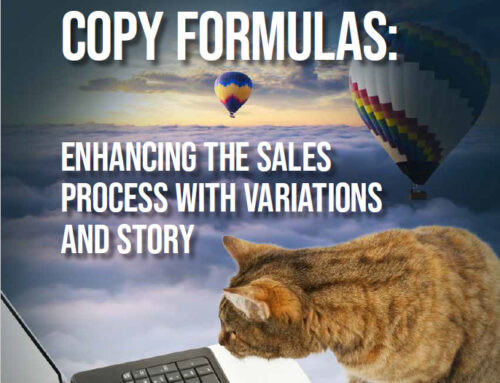There had been a heated discussion between the designer and the sales consultant. The designer produced a cover concept that would be used for a brochure, a presentation, and potentially on the new Home page of the client’s website.
The company was introducing a new product to the medical market that had two significant and relevant advantages over the way hospitals had always done things. The designer and consultant were both excited at the possibilities, so the designer jumped in without any strategy document to guide him.
The designer’s cover concept featured a short headline that didn’t address both advantages, followed by a larger headline with the product name — but hospitals had never heard of this product.
There was a product photo, cropped so you couldn’t see the entire product. One of the product’s benefits was that it’s small and portable, but it wasn’t clear from the photo that the product was either.
At the bottom right corner, there were 4 lines of copy that didn’t explain the specifics promised in the headline, nor did they address the second advantage the headline neglected to mention.
Enter the Sales Consultant: “This is What I Want”
When the designer presented his design, it wasn’t met with enthusiasm.
The consultant told the designer the cover wasn’t going to be effective — but he couldn’t communicate exactly why he believed that, nor what the designer might do to improve the concept. The consultant offended the designer, and the designer stormed out of the meeting. Apparently the sales consultant had originally given the designer the headline to use — and the designer did just that. “I did exactly what you asked for.”
The consultant did his own design — using the same headline, but with a somewhat better subhead that at least gave the audience the specifics of one of the advantages of the product. The consultant’s design featured a large product photo so you could see the entire product, but its size and portability still wasn’t clear.
The designer’s concept was clearly more visually interesting. Unfortunately, it wasn’t driven by the right strategy for the headline, photo, and specific subhead.
The consultant’s concept wasn’t visually interesting at all, but did a better job of communicating half of the story.
“Let’s Get a Third Opinion”
The sales consultant brought in a “referee” to solve the stalemate and get the project back on track. We looked at both designs, headlines, and subheads. We suggested:
- Create a new headline that communicates both benefits, a version of “saves lives and reduces costs”
- Simplify and modify the consultant’s subhead to lead with a verb, rather than a passive statement.
“Pre-frozen . . . (product name) thaws . . .” Leading with a hyphenated term (unless that term is the benefit, which it wasn’t in this case) can be confusing and keep your audience from reading further or comprehending what they’ve read.
The benefit is the fast thawing, so lead with the verb that communicates the benefit: “Thaw . . . with (product name).”
The designer had mentioned “medical professionals” in his 4-lines of copy — but why not address your audience and have them experiencing the benefit, by saying “you” or “your.” (And when you lead with a verb, the “you” is implied.)
We spent maybe 30 minutes talking to the team, and another 30 minutes reading the existing website. It took us maybe another 30 minutes to rewrite their headline and subhead, and write them a strong message that will drive the requests for the demonstrations they want.
Now the designer has what he needed before he started the project — draft copy to use that addresses both key advantages, plus a clearer understanding of the benefits his design and image needs to communicate. The designer can make his next concept more successful from the start.
How to Help Your Designer Be Successful the First Time
Most designers (whether web designers or graphic designers) are better with the overall look, rather than content (although many are great at suggesting headlines and subheads as well — when they have the right strategy).
This designer just needed the right strategic direction. He needed a strategy document, that outlined the two key advantages, along with a draft headline and subhead. And he also needed to understand the key benefits of the product, so his visual could illustrate those benefits.
The sales consultant instantly saw the benefits of our headline, subhead, and body copy. I showed him how leading with a verb strengthened his subhead. And I reminded him that sales copy — whether in a brochure, email, direct mail letter, or website — is most effective when it reads exactly the way he’d say it over the phone or face-to-face. And I proved it to him by reading the 4 lines from the designer’s concept. “That’s never what you’d say in person, is it?” Ah, the light bulb went off and he agreed.
The sales consultant was amazed at how much better our copy was than his or the designer’s. Starting with someone who can guide you to the right strategy at the beginning of a project can save everyone a lot of time, money — and battles.
Need more detail on effective strategy and copy? Our new BEST-SELLING book, “The Results Obsession: ROI-Focused Digital Strategies to Transform Your Marketing” is now available on Amazon!

Learn more about The Results Obsession and see the Table of Contents
The book includes chapters on Content Strategy, Characteristics of Great Copy, Website Copy, Email Copy, and more.






Leave A Comment